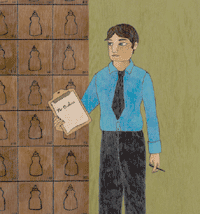At a time when Americans are hunkering down and stripping frills from their lives and when every corporate budget is feeling the blade, chief marketing officers can't afford to shoot dice with their ad dollars. Today, companies need hard evidence that a prospective customer will associate the company's advertising with its brand by way of a persuasive message that will trigger a sale.
But this is not exactly the tune sung by most advertising agencies today. Many operate under the assumption that it is better to keep pouring on the dollars than to stop and risk losing brand awareness in a busy marketplace. Sure, licensing a Beatles song as background music or re-creating Woodstock in a 60-second spot may snare a twentysomething's attention for a minute. But will it sell $60 chinos?
Advertising agencies that claim it's not possible to understand what makes individual consumers whip out their wallets are mistaken. Such understanding is indeed possible, and it's the key to linking ad dollars to buying behavior. George Gallup, the founder of The Gallup Organization, pioneered this concept more than half a century ago. Gallup's no-nonsense view held that in order for advertising to work each member of the desired audience first had to be receptive to the message. He famously told clients that "people don't have an inherent interest in your advertising." That's why he developed techniques for understanding what messages consumers were interested in hearing.
 |
|
|
To enable marketing officers to focus their ad dollars efficiently and affect purchasing behavior, many advertising agencies use a tool called segmentation. This tool entails statistical analysis that combines socioeconomic and demographic information -- education, income, gender, age -- together with information on beliefs, attitudes and aspirations in order to identify the group of potential customers most likely to buy a specific product. For example, segmentation enables a manufacturer of fashion jeans to find and connect with a style-conscious buyer, rather than with someone who just wears functional britches.
The National Dairy Board, a marketing organization for dairy farmers, provides a classic example of the value generated by understanding one's customers before spending ad dollars on them. In the 1980s it became clear to the Dairy Board that per-capita milk consumption in the U.S. was declining at a startling rate, so it collaborated with Gallup researchers to understand the minds of its customers.
The research revealed that milk advertising was missing the 11-to-14-year-old segment of the market, the "tweens" -- no longer children and just entering their teen years. This was a key finding, because if young people stopped drinking milk in their tween years, it would be almost impossible to recapture them as milk-drinking adults. The problem: Advertising was aimed either at older adults through television commercials or at very young children via commercials on the Saturday-morning cartoon TV shows. But younger kids already knew that milk was good for them because in elementary school, they were drinking either milk or water. Precisely for this reason -- because it was a kid's drink -- tweens didn't want to drink milk because it wasn't cool. Yet it was the tweens that the Dairy Board needed to reach, as they were beginning to exert their independence with pocket money for sodas from vending machines or convenience stores.
Once the target customer was identified, Gallup researchers began studying how tweens defined their own personal goals and feelings. And guess what? Girls wanted to be popular and attractive to boys, and boys wanted to be athletic and attractive to girls.
So the Dairy Board's advertising agency designed a campaign around the message "Milk. It does a body good." Aimed at tweens, the new campaign directly tied milk-drinking to what tweens wanted to be: attractive, appealing, athletic. The campaign worked. It slowed the decline in milk consumption, and within 36 months it had reversed the trend. Milk's share in total beverage consumption rose for the first time in five years.
 |
|
|
Taking seriously what is going on inside the minds of your customers is not always a straightforward task. It will often generate competing claims about what customers want to hear, as Gallup's Annette Templeton notes. She recalls working with a vehicle manufacturer that was divided on ad strategy. One camp of the advertising team wanted simply to move vehicles off dealer lots and lobbied for local ads hammering home a discount-and-rebate message. The rival camp wanted to run national ads stressing the brand's attributes, including such fundamental qualities as style, reliability and performance, to make the emotional connection with potential buyers. Who was right?
Gallup research found they were both right. Some of the best prospective customers were price-motivated; others were brand-conscious. So the advertising message had to address both the desire for economy and the pursuit of innovation, distinction and comfort. The result: The company initially focused on brand-building messages to create interest, and then shifted to price-focused ads during peak selling times to trigger actual visits to the dealer.
With such a carefully crafted message, Gallup researchers could then turn to calculating the optimal ad-dollar investment. This number would represent as many buying customers as possible from the audience the ad was meant to reach. This is where the target rating point, or TRP, threshold comes into play. TRPs are a combination of the reach of advertising (the percentage of a target audience that has had a chance to see the ads), multiplied by the frequency with which the ads have been seen. TRP thresholds represent the point at which an advertiser gets maximum return from its ad expenditure.
For one national retailer, Gallup found that effective TRP thresholds varied for different markets and seasons. Gallup built a model that loaded in years of information on key variables that affected the company's business, such as weather, time of year, product quality and popularity. The model helped executives understand how much each variable contributed to their business and how the variables interacted with one another. The key outcome of the process was that the retailer could quantify the return on investment for each ad dollar spent. The model allowed marketing executives to optimize their ad spending by establishing guidelines for how often and when they advertised.
No one ever claimed that it would be easy to link ad dollars to revenue. But when you hear an advertising agency claim that such a link is impossible, keep in mind that it is advertising agencies themselves that discredited their own research departments.
In the 1960s, most major advertising agencies had huge research departments studying consumer behavior and buying habits. Several Chicago agencies even operated consumer interviewing centers in high-traffic shopping malls to see firsthand how consumers made buying decisions. Advertising agencies performed these functions because many Fortune 500 companies didn't have their own market research departments. But as clients came to appreciate the value of consumer information, they built in-house market research capabilities. They also became suspicious of advertising agencies that used research to endorse recommendations. So buying research directly from advertising agencies came to feel like asking the fox to guard the henhouse. Today full-service advertising research departments are an endangered (if not extinct) species.
Next time you're at home watching a movie on TV, play this little game at the commercial break. Sit through those back-to-back 15- and 30-second TV spots. Then see if you can remember the brands that footed the bill for that ad blitz: Name the SUV streaking through the Grand Canyon, the nasal spray that stopped the drip, the power bar that killed the hunger and the long-distance telephone company hawking the nickel-a-minute rate. Of the brands you recall, how many messages grabbed your attention? Enough to make you want to buy or try them? Now, suppose the commercial for your company's new wireless Web-accessible pocket PC and global cell phone was slipped into that clutter. Would you feel good about paying your advertising agency's next bill?
At a time when a single 30-second TV commercial costs on average $332,000 to produce (and that's before the advertising agency's markup) and $4 million to $5 million to air nationwide for three months, companies can't afford anything but a bull's-eye every time. And to score that bull's-eye, you'd better know your customers.